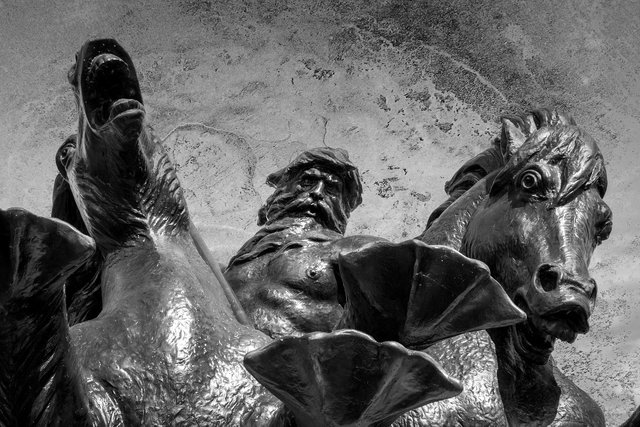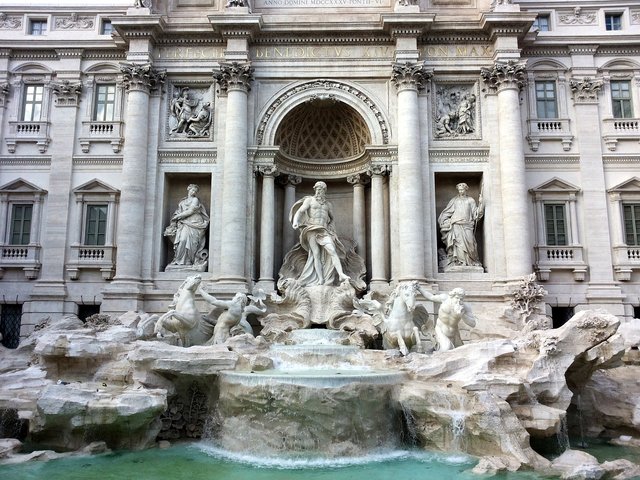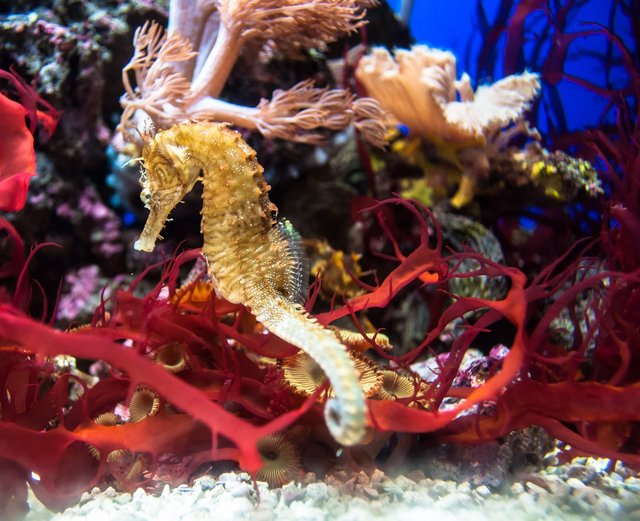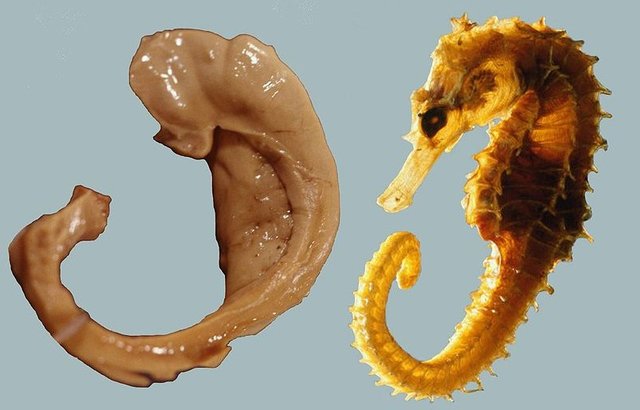The Truth About Hippocamps

There’s something just as mythical as a heffalump that has an equally cool name: the hippocamp. It’s a creature from Greek mythology that looks like a horse on top. But its lower body and tail are more fish-like and it lives in the water. The hippocamp is also not to be confused with a Hippopotamus (a.k.a. Hippo), which also has a cool Greek-derived name, but looks more like a barrel than a fish (and not much like a horse either).
Trevi fountain
If you’ve ever seen the Trevi fountain in Rome or admired pictures of it, you’ve seen hippocamps. Without a close look, you probably thought they were horses. In art and sculpture, horses are on the good side most of the time, but here these animals are not pulling Oceanus’ chariot. These horses have wings; no, they are fins, which makes them hippocamps. And they are fighting with the Tritons, male mermaids who are pulling the chariot of Oceanus.

So the theme “Taming of the Waters” for which the Trevi fountain is known, actually could be “Taming the hippocamps.”
Seahorses
In English, the mythical hippocamp is often called a “seahorse.” And that same name is applied to 45 species of fish in the genus Hippocampus. With arch shaped necks and delicate snouts, seahorses have a horse like appearance that endears them to humans. And being an aquatic species, maybe they are the closest thing to a hippocamp that really exists.

Seahorses are a far cry from the raging horse demons in the Trevi fountain, however, and wouldn’t stand much of a chance if a hippopotamus jumps in a river either.
Hippocampus of the Brain
The term hippocampus also is used for a component of the brain. It sits below the cerebral cortex. This section, when removed, looks much like a seahorse, as you can see from the picture here.
The hippocampus and a seahorse. Creative Commons via Wikipedia.com by Prof. Laszlo Seress.
The hippocampus deals with memory. Specifically, it is associated with the consolidation of short term memory into long term memory. It allows us to distinguish between past and present. Trauma-related experiences get locked there. And in Alzheimer’s patients or with other dementia, it’s one of the first places that shows evidence of damage.
Neptune’s Smallest Moon
And that brings us to Neptune’s smallest moon, which also was given the name Hippocamp by its discoverers, Mark Showalter and other astronomers at the SETI Institute. This week, a new analysis was published of the nature of this moon. It tells us that the moon is around 21 miles (34 km) in diameter.

Image of Neptune's inner moons from NASA via Space.com article linked below.
The small moon orbits very close to Proteus, which is more than 10 times its size. Like earth’s moon, Proteus has been moving slowly away from its planet, so in the past it would have been in the same place as Hippocamp is now. Astronomers say this means that Hippocamp is younger and may be a small piece of Proteus, perhaps dislodged from the impact of a comet.
Why was Neptune’s moon Hippocamp given that name?
"So, officially, it's named after this mythological creature," astronomer Showalter told Space.com. "But partly, in my mind, it's named after seahorses, because I think they're cool."
And now you know the whole truth about hippocamps.
References:
https://www.nationalgeographic.com/science/2019/02/meet-hippocamp-newest-known-moon-neptune-hubble-space/
https://en.wikipedia.org/wiki/Hippocampus_(mythology)
https://en.wikipedia.org/wiki/Trevi_Fountain
https://en.wikipedia.org/wiki/Hippopotamus
https://en.wikipedia.org/wiki/Seahorse
https://en.wikipedia.org/wiki/Hippocampus
https://www.space.com/neptune-smallest-moon-hippocamp-named.html
Images public domain except for those otherwise credited in the text.

I would have thought those were horses in those fountain sculptures.
Also, way cool comparison with the hippocampus.
Another great thing about the seahorse...the only male species I know of that carries births the babes.
wikipedia: The male seahorse is equipped with a pouch on the ventral, or front-facing, side of the tail. When mating, the female seahorse deposits up to 1,500 eggs in the male's pouch. The male carries the eggs for 9 to 45 days until the seahorses emerge fully developed, but very small.
Besides like you I think seahorses are cool.
Great additional info - thanks!
welcome :)
Interesting...I never really thought about any of that before! I also was very surprised that the hippocampus of the brain really did look like a seahorse! Thanks for sharing!
Seahorses have always attracted my attention, it would be wonderful to be able to see one in real life as they seem to me to be interesting creatures. I was aware that the hippocampus of the brain was related to things belonging to memory, although I had not seen that the shape was very similar!
Really informative article Tom. I need to thank you for your mention of Greek language in several cases (proud Greek guy here) :)
I didn’t know that the part of the brain that is related to memory got it’s name because of its shape. But judging by the photo it makes perfect sense
Jeez! I had the mindset that those sculptures were horses, thanks for enlightening me. But i am confused a little, is hippocamps a a part of the brain or a disease of the brain?
In the philippines we have this mythical creature called "tikbalang" that has a horse head and a human body.
Posted using Partiko Android
Interesting. The opposite of a centaur.
It is
Posted using Partiko Android
@donkeypong, I got a few time for understanding about hippocamp. I've heard of these mythical animal from oldest Rome's history book. But you showing great points for understand them.
That's point change my mind. Before read this blog I thought seriously they were horses. I see closely them. But I never thought they were hippocamps. However I believe Hippocamp is mythical animal to the world. That's perfect article you introduced to community.
Was not aware that hippocampus was named after a mythological creature! The shapes do indeed look alike.
I'd heard of that segment of the brain before, but I never knew why they named it that until I saw the picture.
Would be interesting to see what else in the field of medicine/anatomy is named from mythology.
That is pretty weird - I mean the photo of the hippocampus and the seahorse. It is also weird that a lot of fetus look in the first stages the same. (f.e. pigs and humans...)
Yes, it also looks sort of like a fetus. It also reminds me of some other things that are curled up and then unroll, like this fiddlehead fern. A seahorse, of course, does not unroll that much.
Interesting and also beautiful are golden ratio structures in nature.
https://www.mathsisfun.com/numbers/nature-golden-ratio-fibonacci.html
No i have never even heard of hippocamps talkless of seeing it. When i look at the first picture properly it horse face but the skin makes them look differ. Maybe i can call it fish-skin horse
You are a good researcher!
Fish horse; that may be a better term for seahorses also.
But seahorse is not as big as horse is